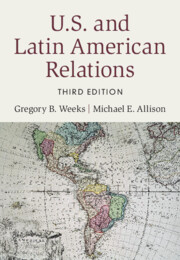Refine search
Actions for selected content:
36807 results in Cambridge Textbooks

U.S. and Latin American Relations
-
- Published online:
- 08 December 2022
- Print publication:
- 01 December 2022
-
- Textbook
- Export citation
Copyright page
-
- Book:
- Software Engineering
- Published online:
- 09 December 2022
- Print publication:
- 08 December 2022, pp iv-iv
-
- Chapter
- Export citation
6 - Design and Architecture
-
- Book:
- Software Engineering
- Published online:
- 09 December 2022
- Print publication:
- 08 December 2022, pp 142-171
-
- Chapter
- Export citation
1 - Introduction
-
- Book:
- Software Engineering
- Published online:
- 09 December 2022
- Print publication:
- 08 December 2022, pp 1-23
-
- Chapter
- Export citation
11 - Raising Intercultural Awareness through Storytelling
- from Part II - Theories, Key Concepts and Approaches
-
- Book:
- The Cambridge Introduction to Intercultural Communication
- Published online:
- 08 February 2023
- Print publication:
- 08 December 2022, pp 140-152
-
- Chapter
- Export citation
15 - Intercultural Communication in Health Services
- from Part III - Application
-
- Book:
- The Cambridge Introduction to Intercultural Communication
- Published online:
- 08 February 2023
- Print publication:
- 08 December 2022, pp 200-210
-
- Chapter
- Export citation
8 - Anthropological Perspectives
- from Part II - Theories, Key Concepts and Approaches
-
- Book:
- The Cambridge Introduction to Intercultural Communication
- Published online:
- 08 February 2023
- Print publication:
- 08 December 2022, pp 101-114
-
- Chapter
- Export citation
18 - Reflections on the Future of Intercultural Communication
- from Part III - Application
-
- Book:
- The Cambridge Introduction to Intercultural Communication
- Published online:
- 08 February 2023
- Print publication:
- 08 December 2022, pp 234-239
-
- Chapter
- Export citation
2 - Software Development Processes
-
- Book:
- Software Engineering
- Published online:
- 09 December 2022
- Print publication:
- 08 December 2022, pp 24-63
-
- Chapter
- Export citation
Figures
-
- Book:
- The Cambridge Introduction to Intercultural Communication
- Published online:
- 08 February 2023
- Print publication:
- 08 December 2022, pp ix-x
-
- Chapter
- Export citation
References
-
- Book:
- Software Engineering
- Published online:
- 09 December 2022
- Print publication:
- 08 December 2022, pp 325-336
-
- Chapter
- Export citation
Preface
-
- Book:
- The Cambridge Introduction to Intercultural Communication
- Published online:
- 08 February 2023
- Print publication:
- 08 December 2022, pp xi-xvi
-
- Chapter
- Export citation
Part I - Introducing Intercultural Communication
-
- Book:
- The Cambridge Introduction to Intercultural Communication
- Published online:
- 08 February 2023
- Print publication:
- 08 December 2022, pp 1-44
-
- Chapter
- Export citation
Index
-
- Book:
- The Cambridge Introduction to Intercultural Communication
- Published online:
- 08 February 2023
- Print publication:
- 08 December 2022, pp 246-247
-
- Chapter
- Export citation
Notes
-
- Book:
- Software Engineering
- Published online:
- 09 December 2022
- Print publication:
- 08 December 2022, pp 314-324
-
- Chapter
- Export citation
Brief Contents
-
- Book:
- Software Engineering
- Published online:
- 09 December 2022
- Print publication:
- 08 December 2022, pp v-vi
-
- Chapter
- Export citation
3 - Rethinking Intercultural Competence
- from Part I - Introducing Intercultural Communication
-
- Book:
- The Cambridge Introduction to Intercultural Communication
- Published online:
- 08 February 2023
- Print publication:
- 08 December 2022, pp 33-44
-
- Chapter
- Export citation
8 - Static Checking
-
- Book:
- Software Engineering
- Published online:
- 09 December 2022
- Print publication:
- 08 December 2022, pp 203-221
-
- Chapter
- Export citation
17 - Intercultural Competence Revisited: Development and Assessment
- from Part III - Application
-
- Book:
- The Cambridge Introduction to Intercultural Communication
- Published online:
- 08 February 2023
- Print publication:
- 08 December 2022, pp 223-233
-
- Chapter
- Export citation
Contents
-
- Book:
- Software Engineering
- Published online:
- 09 December 2022
- Print publication:
- 08 December 2022, pp vii-xiv
-
- Chapter
- Export citation
